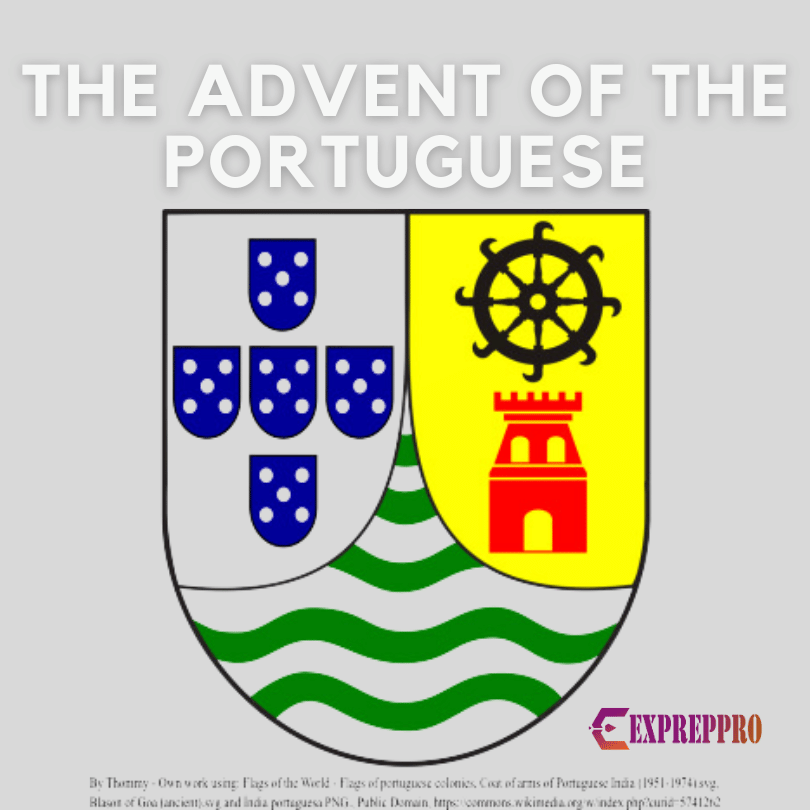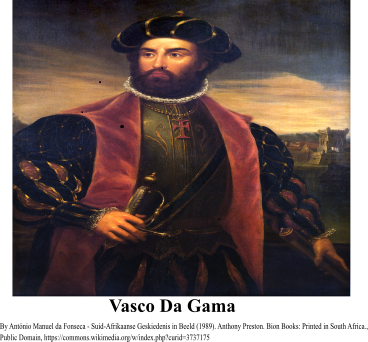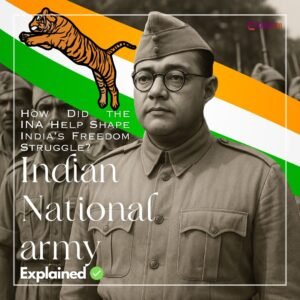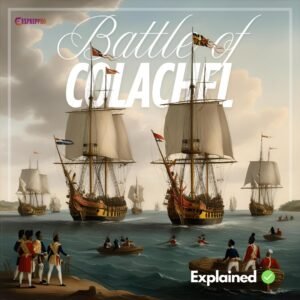
Let’s learn the history of Portuguese advent and the factors that forced Portugal to discover a new sea route to spices and wealth
India had trade contact with the West from time immemorial. The trade was carried out through two routes
- By sea along the Persian Gulf, then through Iraq, turkey and Venice via sea.
- Through the Red Sea route and Alexandria to Venice and Genoa.
The Mongol and Turkish invasions challenged the trade to Europe. After the fall of the Roman empire, the trade fell into the hands of Arab traders. The price charged on Spices by the Arab traders and the Venetian monopoly was also a reason for the Europeans to think about alternate sea routes.
The Portuguese were forced to discover sea routes when the Ottoman Turks challenged the land trade to Europe. Prince Henry, the navigator, devoted his energy to the discovery of a new trade route to the east, the land of spices and wealth. In 1454, Pope Nicholas V extended his support to Portugal’s King Affonso V by issuing a Bull in which the Pope granted the right to govern the land discovered by Portugal beyond Cape Nor up to India on the condition of converting the people to Christianity. Bartholomew Diaz discovered the Cape of Good Hope in 1487.
In 1498, Vasco da Gama landed at Kozhikode, changing the fate of India and Portugal. For India, it was the beginning of European colonialism, and for Portugal, it was a golden opportunity to conquer wealth
Journey of Vasco Da Gama –
Vasco Da Gama sailed from Lisbon along with his brother Paulo Da Gama with a fleet of four ships( Sao Gabriel, Sao Rafael, Carrevel Berrio and the store ship Sao Maria. Sao Gabriel – commanded by Vasco da Gama itself) and a crew of 170 men in 1497. The Portuguese King Manuel I chose Gama for this daring task. Bartholomew Diaz also sailed with them because he had the prior experience but stayed in the Cape Verde islands. At last, they reached Melindie.
From Melinde, Vasco da Gama secured the service of a Gujarati pilot and started his voyage to Calicut on April 24. Even though the pilot failed to identify the locality due to heavy rain, on May 27, 1498, they landed off Pandarani or Kappadu near Calicut (Kozhikode), Kerala.
The Zamorins, the Hindu ruler of Calicut, welcomed them. But Gama’s request for permission to appoint a factor behind him in charge of trade was rejected by the Zamorin, and the ruler demanded payment of customs duty according to the law of the land. Moreover, Gama faced opposition from the local arab traders of Calicut.
Vasco Da Gama then moved from Calicut to Kolathirinadu (a small princely state near Calicut). The local king of Kolathunadu (Kolathiri Raja) allowed the Portuguese to use facilities for trade at Cannanore. The ruler even entered an informal agreement with the Portuguese. The Gama reached Lisbon in 1499. There, he got a hero’s welcome because he brought cargo worth 60 times the cost of the expedition, along with a new trade route to wealth. The king conferred “Admiral” on Vasco Da Gama to honour his success.

ARRIVAL OF PEDRO ALVARZ CABRAL –
The Cabral (the discoverer of Brazil) reached Calicut with six ships( he started his journey with 33 ships and 1500 men). Cabral’s agent, Aires Correa, arrived at a settlement with Zamorin, and they got the right to construct a factory at Calicut. But the local competition created troubles. Cabral, in retaliation, massacred the Arab crew of trade vessels. Then he unleashed the premeditated barbaric acts towards the Calicut, which infuriated the people. The mob destroyed the factory and killed a dozen Portuguese on Land. This incident forced Cabral to leave Calicut in panic.
Cabral then sailed to Cochin in December 1500.Due to the informal treaty between Cabral and Raja of Cochin, they got permission to construct a factory. Cabral also received cordial invitations from Kollam( Desinganadu) and Cannannore. Instead of Kollam Cabral, choose the option Cannanore. From there, he got more cargo and left Kerala coast to Lisbon.
CARTAZ SYSTEM –
In 1502, the Portuguese created a licensing system to control trade and monopoly of trade in the Indian Ocean. The vessels are not allowed to sail without Cartaz. This licencing system brought income along with complete control over the Indian Ocean. The Portuguese fleet patrolled the sea, and the vessels without Cartaz were attacked and sunk in the ocean.
JOAO DE NOVA –
Joao De Novo had prior information regarding Calicut’s hostile attitude. So, the captain avoided Calicut. He sailed to Cochin and Cannanore. He was fortunate to get the cargo from Cochin and Cannanore.
SECOND MISSION OF VASCO DA GAMA –
The defeat of Cabral by the Calicut fleet made King Dom Manuel upset. So, the king dispatched 15 ships and 800 men to India under Vasco Da Gama. He first stationed at Anjidiva and attacked the trade vessels.
Then he moved off the coast of Calicut and, attacked both trade vessels and hijacked a Haj vessel. Then he gave Zamorin an ultimatum and asked him to come in person for talks. Instead of Zamorin, a messenger and a boy were sent for talks. The infuriated Gama chopped the ears and nose of the messenger and killed the hostages.
At the same time, Gama got a cordial reception at Cannanore and Cochin. He dispatched two ships to Kollam, and they returned with cargo.
On the way back, they were attacked by the Zamorin’s Fleet but escaped without any losses.
REASON FOR THE CORDIAL RELATION OF COCHIN WITH PORTUGUESE –
The Portuguese utilised the clash between Cochin and Calicut. In 1503, Calicut attacked Cochin. The Cochin forces suffered heavy losses. The ruler of Cochin took refuge in the Elangunnapuzha temple. The Portuguese, under Lorenzo Moneno, defended their fort. Due to the monsoon, Calicut stopped their operations. In September 1503, the Portuguese under Albuquerque arrived at Cochin and helped Raja to recover his lost territory.
FRANSISCO D’ ALMEIDA –
In 1505, Almeida was appointed as the first viceroy of Portuguese possession in the east, and the Portuguese government entrusted him with strengthening the forts of Anjidiva, Cochin, Cannanore, and Malaca. The fort of Cannanore was named Fort Angelo.
The growing Portuguese power on the Kerala coast alarmed the Zamorins, which resulted in clashes between both. During the time of Almeida, the relationship between Cannanore and the Portuguese was also strained. The Portuguese violated the safe conduct guaranteed to the Muslim traders of Cannanore.In 1506, Almeida’s son intercepted the Zamorin’s fleet and inflicted heavy losses even though he got killed.
The Zamorin decided to fight. The Kolathiri Raja (Cannanore) besieged the Fort of Angelo for four months, and this siege continued till the fleet of Da Cunha arrived at the scene. The Kolathiri requested peace and accepted Portugal’s terms and conditions. He also compelled the ruler of Sri Lanka to pay him the tribute of Cinamon and Elephants.
In 1509, the Portuguese defeated the combined fleet of Egypt and Zamorin and took revenge for the Portuguese defeat in the Battle of Chaul. This victory made the Indian Ocean virtually a Portuguese sea for the next century. He was responsible for the blue water strategy or policy to maintain supremacy on the sea, which enabled them to expand their operations towards the Persian Gulf and the Red Sea. In the battle of Chaul, the Potugal fleet was defeated by the Egyptian fleet under Mir Husain. In 1509, Almeida left India.
AFFONSO DE ALBUQUERQUE –
To destroy the power of Zamorin, he ordered Marshal Cutinho to attack Calicut. The palace was attacked, and the city was set on fire. The brave soldiers of Calicut retaliated, resulting in the withdrawal of the Portuguese. Albuquerque was wounded, and Marshal Coutinho was killed. Then, Albuquerque changed his strategy, and to protect Portugal’s interests in Kerala, he solved the quarrel with Zamorin.
Goa was a strategically located natural harbour, so he captured Goa from the Bijapur sultan in 1510. This decision enabled them to control the Kerala coast and monitor the situation on the Deccan and Gujarat coasts. They even blocked the ports of Dabhol and Danda, destroying the trade of Bijapur.
The treaty of 1513 between the Portuguese and Zamorin was a victory for him. He is responsible for enlisting Indians in the Portuguese army, Prohibiting sati, introducing Portuguese-style school education, Strict administration of justice and new coinage. He created the policy of mixed colonies. This policy encouraged Portuguese men to marry local women and settle inside the fortress with privileges. He occupied the island of Hormuz in 1515. He passed away at Goa in 1515.
LOPO SOAREZ –
Lopo Soarez attempted to kill Zamorin ( it was unsuccessful), and this attempt renewed the hostilities. In 1516, he entered a treaty with Quilon (Kollam) to acquire pepper and spices at the rate prevailing at Cochin.
DE SEQUIERA –
Under this grace, the Cochin raja attacked Calicut. This unsuccessful attempt fuelled the hostilities between Calicut and the Portuguese. There were open clashes between the Muslim subjects of Zamorin and the Portuguese. They attacked Cannanore, Cochin port, and Portuguese vessels under the leadership of Kunjali Marakkar, the naval chief of Zamorin.
These defeats made Vasco Da Gama return to India as viceroy in 1924. The Gama forced the Cannanore raja (Kolathiri) to surrender Balia Hassan, their naval chief. Later, the Portuguese killed Balia Hasan ( Henrique De Menezes, the successor of Vasco da Gama, ordered the execution). He also dispatched a fleet under D’ Souza to defeat Kunjali Marakkar. After three months, he died at Cochin on December 24, 1524. He was buried in St. Francis Church, Cochin. Later, his mortal remains were carried back to Portugal.
THE SUCESSORS AFTER VASCO DA GAMA –
The successors were responsible for the occupation of Daman, Diu, Salsette, Bassein, Chaul and Bombay. The San Thome near Madras(Chennai) and Hoogly developed into the Portuguese trade posts.
In 1531, the Portuguese attacked the Diu and Daman, but the commander Rumi Khan repulsed the attack.
DECLINE OF PORTUGUESE POWER –
The Portuguese relied on the power of the sea based on fortified ports and showed less interest in the inland areas.
The collapse of the Vijayanagara Empire was a death blow to the Portuguese in India.
In 1540, by order of the Portuguese king, almost all temples in Portuguese-controlled Goa were destroyed. The introduction of the Inquisition in Goa after 1650 resulted in the cruel persecution of Hindus on an unprecedented scale.They also plundered the temples in other regions like Kerala for wealth(temples in Tevalakara in Kollam district).
They also destroyed many mosques and harassed Muslims. The Portuguese even tried to Latinse the Syrian Christians of Kerala, which resulted in a revolt at the Coonan Cross. The Portuguese partially destroyed the famous Jewish synagogue of Mattancheri. These actions created a hostile local population.
The government in Lisbon conducted a public auction for appointments in India. The highest bidder got the appointment. The unmarried orphan girls were sent to India with appointment orders as dowries to the person who was ready to marry the girls. This created a moral turpitude and corruption among the ranks.
DECLINE OF PORTUGUESE POWER –
Portugal was annexed to Spain in 1580 under Philip II, and Portugal’s interests were sacrificed for Spanish interests.
Their interest in Africa and Brazil resulted in a heavy drain of human resources. The competition with the Dutch resulted in the exhaustion of Portuguese power beyond repair.
The Portuguese were unsuccessful in monopolising the pepper and spices trade. By the end of the 16th century, the Mughals promoted trade via sea and land routes. The Gujaratis could get a supply of spices from Kerala and Anchin in Sumatra to Egypt via sea. By this time, the Portuguese navy had become a paper tiger.
The power concentration in Goa with weak persons at the helm adversely affected the trade on the Malabar coasts.
The Ali Adhil Sha of Bijapur, Ahmednagar Sultan and Zamorin agreed and decided to attack the Portuguese in their dominions. Even though the attacks were unsuccessful, they severely threatened the Portuguese power.
In the 17th century, they lost their Indian settlements to the Dutch and English. Marathas captured Salsette and Bassein in 1739. At last, the Portuguese retained only Goa, Daman and Diu.
The acute financial insolvency faced by the administration is another reason for their decline.The Jesuit missionaries worked independently and continued to get funds from the Portuguese treasury, which resulted in the drain of wealth.
Coruptiption and inefficiency in administration also contributed to their decline.
THE EFFECTS OF PORTUGUES CONTACTS –
- The Portuguese introduced Cashew-nut, Tobacco, Custard apple, Guava, Pineapple and Papaya.
- They popularised the scientific cultivation of Ginger and Pepper on a mass scale.
- They promoted coconut tree cultivation and popularised an improved variety of coconut seeds.
- Coir became an essential export item.
- The art form, Chavuttunadakam, was popularised under the patronage of Portuguese missionaries.
- They opened up direct trade with Japan and the Philippines. From Japan, they sourced Silver and Copper.
- The Portuguese carried fine-quality Indian textiles to the Philipines, South America and other places.
PHOTO CREDITS- Wikimedia commons
By Thommy – Own work using: Flags of the World – Flags of portuguese colonies, Coat of arms of Portuguese India (1951-1974).svg, Blason of Goa (ancient).svg and Índia portuguesa.PNG., Public Domain, https://commons.wikimedia.org/w/index.php?curid=5741262
By António Manuel da Fonseca – Suid-Afrikaanse Geskiedenis in Beeld (1989). Anthony Preston. Bion Books: Printed in South Africa., Public Domain, https://commons.wikimedia.org/w/index.php?curid=3737175



